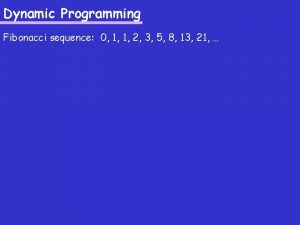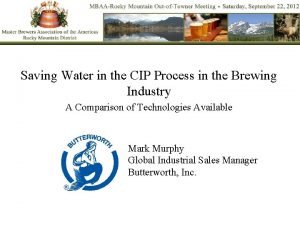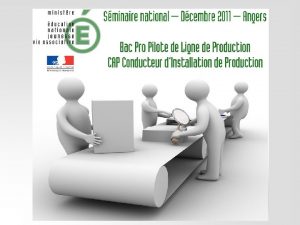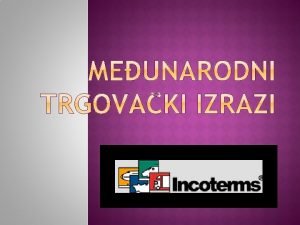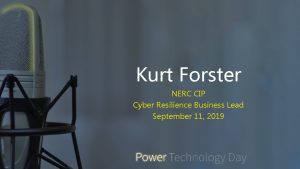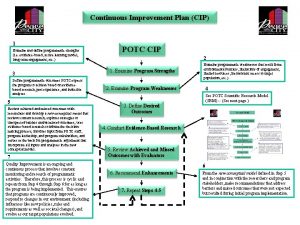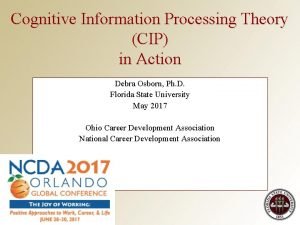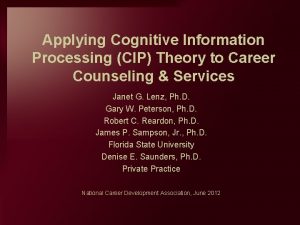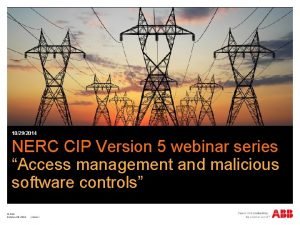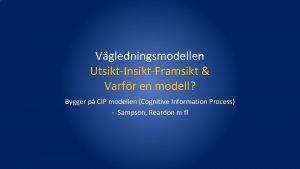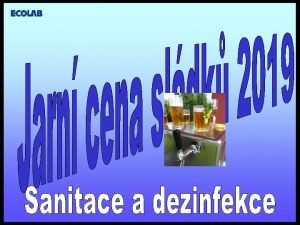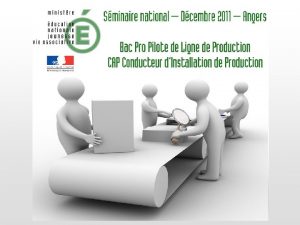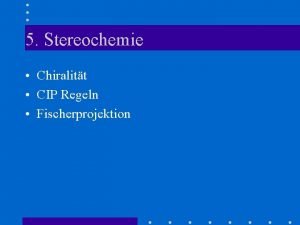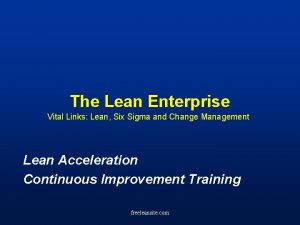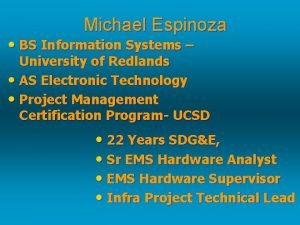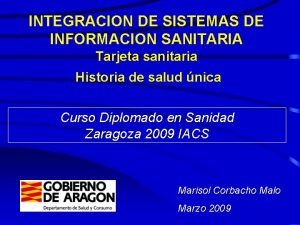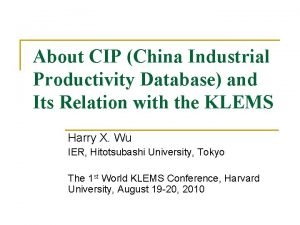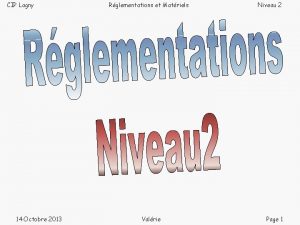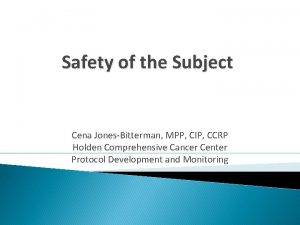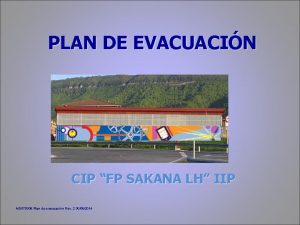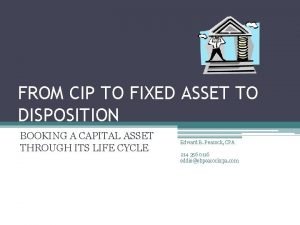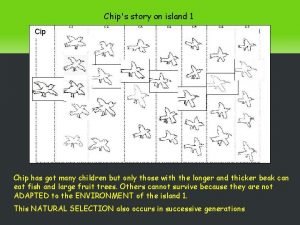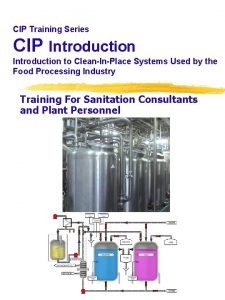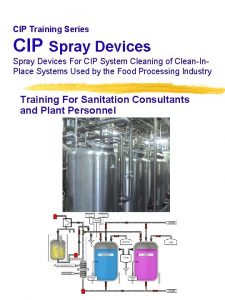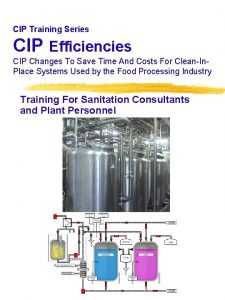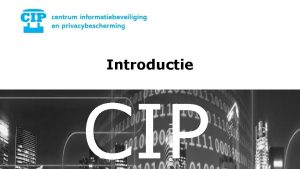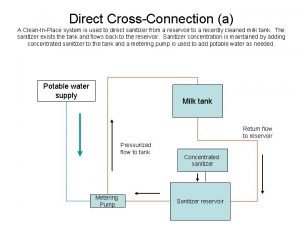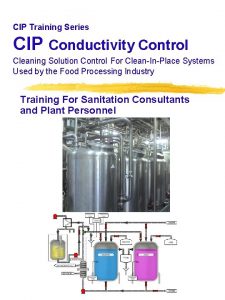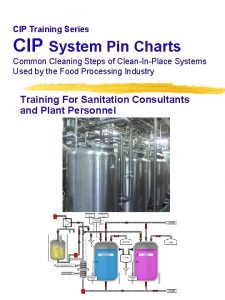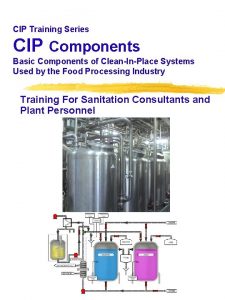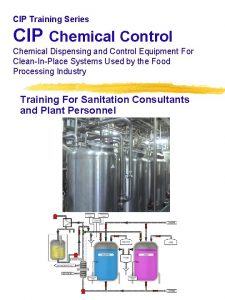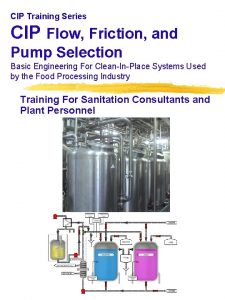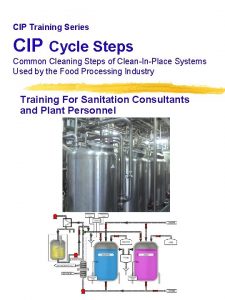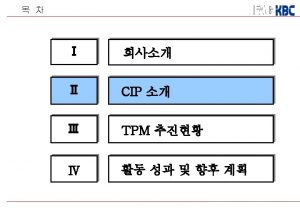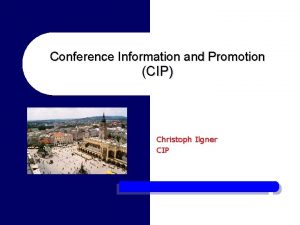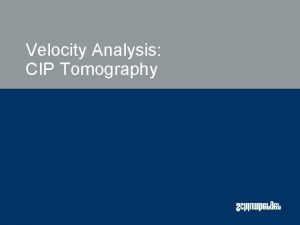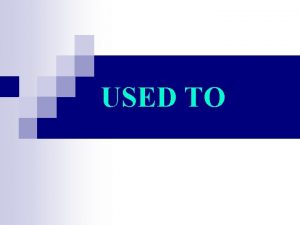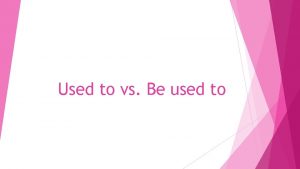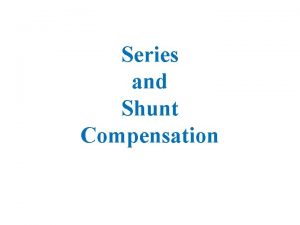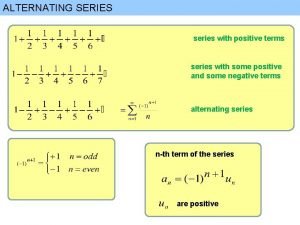CIP Training Series CIP Programming CleanInPlace Systems Used





































- Slides: 37

CIP Training Series CIP Programming Clean-In-Place Systems Used by the Food Processing Industry Training For Sanitation Consultants and Plant Personnel

CIP Programming Proper/Effective Programming z Provides the required level of cleanliness z Makes efficient use of chemicals, water makeup, energy, and time z Observation of many CIP systems in food plants has shown many have been installed and programmed without being able to perform the essential functions. z Often programs have been written to be “safe”, meaning few (if any) programmer return trips to fine tune the system. z Food processors often provide a large capital expenditure on “state-of-the-art” systems and may have them programmed by personnel without knowledge of basic CIP requirements.

CIP Programming Purpose of CIP Steps z Pre-rinse y Food product displacement and removal of gross soils y In the dairy and related food industries melt butterfat to prevent contamination of the wash solution y Loosen protein soils y Provide thermal energy (90 -110°F) to minimize thermal shock of high heat wash steps (e. g. , stainless tanks and silos, etc. ) z Wash y May have one wash step (generally alkaline or chlorinated alkaline) or two wash steps (one of the above and an acid wash step). y Remove remaining soil through detergency and chemical reaction (e. g. , hypochlorite and alkali hydrolyze/oxidize protein soils; acids react with and dissolve minerals) y Assist in breakdown of biofilm if present y Additional thermal energy (130 -150°F) improves results and increases chemical reaction rates z Post-rinse y Removes residual soils and suspended soils y Prepares food contact surfaces for sanitizing z Sanitize Step y Microbiological lethality to a 5 log level (99. 999%) y 60 second contact (minimum) using ambient water typically

CIP Programming Common Programmed CIP Steps z Pre-rinse removes loose/water soluble soils immediately after processing ends. y Removes as much soil as possible or wash chemical will be depleted and wasted, or, even worse ineffective. y Flushing out most traces of foam means good soil removal. z Wash cycles of chemical solutions remove soils by reaction and various detergent properties. y Variable factors of cleaning—temperature, time, mechanical action and concentration—are set properly. y All four factors can be programmed into the PLC z Post-rinse removes all the wash cycle solution and dissolved/suspended soil. y Intermediate rinsing is done between wash cycles if there is more than one wash cycle (alkaline and acid washes). y Determine length of rinse time by various means: x x Visual checks – rinse to clear (remove all color, haziness) Conductivity – rinse to conductivity of water source or accepted standard p. H – rinse to an acceptable p. H close to that of the makeup water COD – perform chemical oxygen demand lab tests – simple and accurate z Sanitize cycle applies sanitizer to all equipment surfaces for the proper contact time through one of three methods: y Once-through and an air blow push y Recirculated at ambient temperature (no heat) y Programmed sanitize and water chase (may be needed for long, complex circuits with higher head pressures)

CIP Programming Efficient Operation of CIP Systems Tanks (Single-Use) Minimum Requirements� z The single-use system CIP tank must hold enough volume for continuous flow for each burst rinse preset time. Determine by: y Maximum flow rate of the CIP supply pump y Minimum make up water flow rate and the maximum burst rinse time y Number of burst rinses and programmed times y Number and duration of pump downs must be optimized for each CIP system circuit z The tank must hold enough volume to fill or flood the circuit with the largest internal volume. y Anything less will run out of water or cleaning solution during the cycle reducing efficient operation (starved supply pumps, decreased physical contact force, and less solution contact time). y This is why the balance of flow is so important – supply flow balanced with return flow.

CIP Programming Efficient Operation of CIP Systems Tanks (Reuse) Minimum Requirements� z Reuse CIP system tanks have similar requirements. Rinse supply tank must have the volume capacity to allow continuous flow for the length of each burst pre-rinse. z Wash tank must hold enough volume for the largest cleaning operation volume holdup. z Rinse reclaim tank should be large enough to hold all of the wash solution return and/or recovered rinse water. y Route the alkaline wash solution to the alkaline CIP tank or rinse recovery tank based on conductivity. If the conductivity falls below the minimum setpoint for the wash tank, the flow diverts to the rinse recovery tank or to the drain. y May also reclaim the post-rinse to the rinse recovery tank z CIP tank high level/low level sensors should be incorporated into the controller to automatically switch to the rinse supply tank when empty or to add water when the level becomes low.

CIP Programming Efficient Operation of CIP Systems Tanks (Reuse) -- Continued Minimum Requirements� z Solution supply tanks may have an automatic skimming device to remove any floating solids. y The tank overflows to an open pipe x It can be located inside the tank (a vertical pipe open at top near the fill level that drains out the bottom of the tank to the drain). x It can be designed as an elbow (open to the top of the tanks fill level) that leads to an exterior vertical pipe that flows to the drain. z Each tank should have a drain valve y Can manually or automatically operate to allow ease of draining and cleaning. z Each wash tank should have a small sprayball that includes a program in the PLC that enables the washing of the CIP tanks (i. e. , the upper tank area and lid)

CIP Programming Efficient Operation of CIP Systems CIP Supply Pump (Minimum Requirements� ) z The CIP supply pump must be sized so that it will deliver the minimum flow required to the largest spray device to be used. z Provide a minimum cleaning flow velocity of 5 fps to the largest pipeline circuit (or higher based on pipeline diameter – 8 -10 fps or more for 3 -4” lines). z If there are multiple CIP supply pumps the system (tanks etc. ) must be engineered to provide hydraulic balance when both pumps are providing maximum CIP supply at the same time. y Design for flexibility with regard to flow rate and volume. The CIP tanks must be sized according to the volume needs of both CIP supply pumps and their largest circuits. The flows must be balanced for the return flows also. Fresh Water Supply z Must deliver enough make up water to prevent the rinse supply tank from running below the low level sensor at the minimum water pressure available.

CIP Programming Efficient Operation of CIP Systems Heating (Minimum Requirements� ) z The heating equipment selected must be a design capacity to provide the desired water temperature, in the time required. y Choices are in-tank steam addition, in-line heating, or a shell-and-tube heat exchanger. y The shell-and-tube heat exchanger must be sized to heat solutions quickly, or the PLC programmed “delay to temperature” increases CIP wash time. z Shell-and-tube (or plate-and-frame) is best. y It eliminates contamination of the CIP solutions with boiler treatment compounds. y The condensate should be returned to the boiler—to lower chemical treatment costs due to its high purity and for its heat content. z If cold makeup water and a tempered pre-rinse is required, the steam valve, incoming steam line, and heater is sized to provide steam at the lowest available boiler pressure. z For in-tank steam heating, steam solenoids and steam traps need regular maintenance to prevent BTU losses and CIP wash tank dilution.

CIP Programming Chemical Dispensing Cleaning Products z Dispensing pumps are sized to easily provide the target concentration before the system achieves cleaning temperature. Sanitizer z The sanitizer feed pump is sized to dose the use concentration in the water flow when injected into the suction-side of the CIP supply pump. z Often a needle valve is needed to fine-tune the sanitizer dose rate to match the CIP supply pump flow. z Air blow push of sanitizer (through the line circuit) requires the sanitizer dispensing pump to dose the sanitizer in proportion to the CIP flow rate. y Acid sanitizer (1 fl. oz. /6 gal. use rate) in a 100 gpm water flow is pumped at 100/6 = 17 fl. oz. /min. for the dispensing rate. y If the program is 20 seconds dispensing for tanker trucks or silos that calculates to 6 fl. oz. x 20 sec. /60 sec. /min. ) x 17 fl. oz. /min. = 6 oz. dispensed.

CIP Programming Chemical Dispensing Sanitizer - Continued z Recirculated sanitizer—volume of sanitizer dispensed per circuit must be correct for the volume of water for each circuit y Unlike once-through with an air blow - a recirculated solution does not have to have the sanitizer dispensed at the proper ratio to the CIP supply flow rate - just have the correct sanitizer amount dispensed based on total water volume in the system. y Acid sanitizer (if the use rate is 1 fl. oz. /6 gal. ) -- in 150 gal. of CIP circuit water volume - dispense the sanitizer @150 gal. /6 fl. oz. /gal. = 25 fl. oz. z However, it is always best to dispense the sanitizer into the CIP line at the proper sanitizing concentration. Why? y Due to potential valve sequencing and circuit routing. y Accounts for the possibility of further water additions. y So you always know you have the right concentration. Sanitizer solution is correct concentration at this point Sanitizer Dispensing Water CIP Pump

CIP Programming CIP Controller z A CIP system can sometimes be operated manually in small operations, but it is not desirable. y An operator seldom has one job task to perform and distractions may cause poorer results. y Most CIP operations are too complex in larger food facilities to operate manually – PLC control and mechanical operations can be sophisticated and complex. z Saving capital expenditures in the purchase of a CIP system (such as a sophisticated PLC) and getting a limited unit may result in wasting money during the long life of the system (time, water, steam, and chemical products). y Think in terms of ROI for product quality due to good sanitation and time efficiency. y Buy the best CIP system affordable since it is critical to food plant operations. z When purchasing a CIP system, the flexibility of the controller is important. z When controllers have expanded capabilities, custom tailored programming for each vessel or circuit being cleaned is always desirable and achievable. z Compromising may be necessary due to equipment limitations, but is costly in water and chemical usage.

CIP Programming CIP Controller z The controller must be designed so that changes can be made in the plant without calling an outside programmer (larger plants). z Once the basic cleaning steps are determined, capabilities are needed to adjust step times for efficient operation. z Changes may need to be made on valve sequencing and valve pulsing during circulation of cleaning solutions. z The return line to the drain must be installed in such a way that allows observation of return flow. z Drain collection funnels are preferred. The newest PLC’s have a lot of programming capability including miscellaneous details, information and graphics such as proximity switches and flow verters displayed on screen.

CIP Programming Cleaning Parameters - Control Times and Temperatures z Wash times and temperatures should be agreed upon by the food plant personnel and the sanitation consultants. It must not be left to the discretion of equipment installers – often they do not have the necessary sanitation expertise. Delay to Temperature z “Time at temperature” and “Delay to temperature” -- Cleaning step times should be based on the time at the set point cleaning temperature. Timing this step begins when this temperature is reached. z The timer stops if the temp falls below the set point and restarts when it again reaches the set point. z Single-use systems rarely have heaters sized to bring the solution up to temperature on its first pass through the system. High and Low Temperature Controls z The controller should include an alarm and an automatic shutdown in event of high temperature. z Low temperature conditions should result in a “hold” and also an alarm.

CIP Programming Cleaning Parameters - Control Concentration Control z A means of controlling concentrations should be provided. Usually a conductivity controller with timed control of chlorine or other additives provides the control. z Timed additions of charge and boost is an optional method of controlling chemicals. z There should be automatic recharging of chemical or an alarm with an automatic “hold” if concentration is low. z In-line conductivity probes on the vertical discharge side piping of the CIP supply pump is usually best (for control). In-tank probes can also be used as an alternative for control (although the alkaline tank probe should be periodically cleaned). Acid tank probes generally do not need to be cleaned. In-line probes are self-cleaning. The in-tank or CIP supply probes may be set up to control conductivity with the return side for read-only (validation). y Also required for CIP validation is a return flow temperature sensor and a return sensor flow. Time is in the PLC program and on the chart recorder. z Conductivity control can be designed into the CIP system or can be supplied by the sanitation company and activated by the CIP microprocessor in CIP mode. The standard requirement is just a 4 -20 m. A signal.

CIP Programming Cleaning Parameters - Control Concentration Control z Multiple conductivity probes may be needed for CIP systems utilizing more than one CIP supply pump. y Example (for control of an chlorinated alkaline product): If two CIP supply pumps operate at the same time, CIP pump 2 may control the conductivity of the solution; when the CIP supply pump 2 stops, the conductivity control may default back to CIP supply pump 1. z Chlorine (sodium hypochlorite) add may occur by dispensing during the cleaning cycle. The chlorine add time (and optional: the interval time) may be programmed. y I. e. , delay times between chemical dispensing: Time on, time off, time on, etc. z If control is not by the CIP system PLC, then a signal activates the dispensing panel to control times and conductivity. z Refer to CIP training module 8. CIP Chemical Control

CIP Programming Proof of Flow z At the start of a cycle a means is needed to determine that the rinse water is returning to the system. z Proof of flow devices are used to sense the presence of returning solution—often they are pressure switches. z The system is programmed so that if the switch is not satisfied within a preset time, the system shuts down. y This allows cancellation of the cycle before contaminating solution is pumped into any tank or line that is in food product service. z An alternative to a pressure sensor is a flow sensor (e. g. , magnetic flow meter). z Flow sensors can be better, since there can be pressure in the line without flow.

CIP Programming Proof of Flow - Cont. z Flow meters should be downstream of CIP supply pumps. They allow confirmation of minimum flow through each circuit. z They are useful in the troubleshooting of various problems, such as: missing sprayballs, faulty valve sequencing, and improper or missing connections. z A flow meter provides a necessary interlock to assure system flow prior to opening steam or chemical valves. y “Interlock” means that certain CIP functions are dependent on other functions being met first. For this example, if there is no return flow, no steam or chemicals are added. z Or, as mentioned, at least use a pressure sensor (downstream of CIP supply pump)— interlock the steam supply and chemical dosing.

CIP Programming Automatic Valve Sequencing z All cleaning circuit air valves, including the CIP system valves, tank inlet and outlet valves, and circuit line valves (which may be part of a large valve cluster) should cycle automatically. z In large plants with many line circuits the control of valves may be complex. z Cleaning circuits may remain dirty due to various problems with regard to valve operation, such as: programming errors, valves in poor condition/repair, missing air lines, and stuck valves to name a few. From A & B Process Systems

CIP Programming CIP Documentation z Proper documentation of the CIP programming is critical. z Many programs are so complex that visual observation of all cycle functions is virtually impossible. z Every CIP program change must be documented. z This documentation is important to provide good troubleshooting.

CIP Programming Tank/Silo Cleaning z The most efficient rinsing is by short bursts. z A series of burst rinses efficiently removes the bulk of the soil from tank surfaces to the tank bottom, where it is pumped out to drain. z Two or three bursts, usually 20 to 40 seconds in duration is common. This is followed by a complete pump out providing a thorough surface rinse. z One long burst is much less efficient because the soil, particularly foam, tends to lay in the bottom of the vessel and then contaminates the wash solution. z Recirculating the rinse is inefficient for soil and chemical removal. Once in a while it has been observed to be done. This practice may be due to a lack of CIP knowledge/understanding of basic CIP principles or as an attempt to reduce water usage.

CIP Programming Tank Cleaning z A reclaim rinse (rinse recovery) is best. y This is the post-rinse water from the preceding cycle, or, for a single use system, may be a mixture of the wash solution and the post-rinse water from the previous cycle. y It is essentially “free”, in terms of economics, because you have used it and paid for it. Reclaim rinse contains some chemical and BTU’s (it is warm); these qualities will make for a better rinse. z The initial burst pre-rinse (containing the bulk of the recoverable food) may be reworked into manufactured food product. z To prevent contamination of product (wrong tank is connected for CIP), the first rinse can be fresh water with a “proof of flow” sensor to stop the cycle if rinse water isn’t returned within a preset time. z Heating rinse water to 90°F to 110°F provides more effective rinsing than cold water, especially with milk fats, which are not removed at cold temperature. y A cold pre-rinse in an important issue we observe with many CIP systems.

CIP Programming Tank Cleaning Engineering z z z The piping must be analyzed to find the times needed to enable the solution to reach the desired location (time and flow). Using a typical CIP flow rate of 100 gpm, determine the volume of water to fill the empty lines to the vessel being cleaned. CIP supply lines usually range between two to four inch diameter stainless piping. The volume to fill one foot of each of these sizes (pipe diameters) is: Pipe Diameter Gal. /Ft. of Length 2” 0. 16 2. 5” 0. 25 3” 0. 36 4” 0. 65 The first burst rinse should spray the tank for ~30 seconds. Example: If the supply line to the tank is 175 feet of two inch line, calculate burst rinse time: 1. 2. 3. 4. 175 feet x 0. 16 gal. /ft. = 28 gallons volume to fill pipe 30 sec. spray time x 100 gpm = 50 gallons volume for burst rinse The total volume is 78 gallons (28 + 50). This calculates out to be a first burst time of ~45 seconds [Burst Time = 78 gal. /100 gpm x 60 sec. /1 min = 45 sec. ] The suggested programmed time may be a little higher, say 50 seconds (for the first burst). This method is generally how you figure out CIP program rinse times.

CIP Programming Tank Cleaning Engineering z The first burst should be followed by the time needed for a complete pump out. This should be done by observation. y The pump out (“pumpdown”) would be about double the effective spray time or one minute (30 sec. burst x 2). z The second burst rinse should again provide a 30 second spray time—this time the lines are full—so only 30 seconds will be required (~50 gal. water). y The pump out time should again be one minute. z The third burst and pump out time should be identical to the second. If an air blow is used on the return line, it should follow the pump out time. z This type of rinse programming leaves the system essentially free of rinse water. z At the start of the wash cycle, as with the pre-rinse, time is needed to fill the lines. If the entire system (both supply and return) has been air blown, the return valve to the solution supply tank can be opened at this time. z If either or both of the lines (supply and return) have not been air blown, the return valve should remain directed to the drain for a sufficient time to clear the system of rinse water. The best method is through actual observation. z In systems equipped with a CIP monitor, the increase in conductivity (u. S) to a certain threshold setpoint or temperature of the return solution will signal the return valve to the wash tank to open. These methods minimize dilution of the cleaning solution with rinse water.

CIP Programming Tank Cleaning Engineering Cont. z z z The CIP program is equipped with a “delay to temperature” that delays the wash time count until the set point temperature is reached. Once reached, the timing of the wash cycle is started. The wash “time at temperature” of tanks should be ~20 minutes. It is determined by soil conditions and cleaning results. Temperatures in the 135°F to 155°F range are often used. After circulation of the wash step, if the u. S is above a certain setpoint, the valve to the wash tank remains open for return; the recovery tank and drain valves are closed. Flow is returned to the wash tank until full or conductivity falls below the return setpoint. y y If the wash tank is filled or conductivity falls below a minimum u. S setpoint, the valve to the recovery tank is opened (if the CIP system is equipped with a recovery tank) and the return valve is closed to the wash tank. Once the fill level is satisfied in the recovery tank, the return valve is closed and the drain valve opens for the remaining rinse. x Control valves for routing of rinse water or CIP wash solution. Temperature RTD Conductivity Sensor Flow Sensor

CIP Programming Tank Cleaning Engineering Cont. z Brief comments on the programing of air blows: y At the end of the wash cycle, the supply line should be air blown as soon as the CIP supply pump stops. After the vessel solution has returned, the return line should be air blown (if equipped). y If air blows on both the supply and return lines are used, the return valve may be diverted to a reclaim rinse supply tank. y If air blows are not used, the return valve directs the solution to the supply tank until temperature or conductivity signal the presence of rinse water. Slightly overfilling the supply tank to cause any floating solids to overflow to the drain is beneficial. (This happens through the overflow pipe outlet. ) z The rinses after the wash step, i. e. , post-rinse burst one and two (and the returns), should be timed the same as the pre-rinse. All returning water may be sent to a reclaim tank. The return valve to the reclaim tank should divert to drain when full (or when the second burst and return are completed). z An air blow on the supply line should be used after the second burst to clear the line of water. z The next step should be sanitizing with the sanitizer injected into the entire burst rinse with the same volume used as the first. This will fill the line with a sanitizing solution and spray the vessel. An air blow should be used to clear the supply lines.

CIP Programming Tank Cleaning Engineering. Cont. z CIP water use per step: z For the example of 175 ft. of 2 inch piping, a tank can be washed with the following usages (example with rinse recovery under ideal conditions): Program Step Gallons Pre-rinse first burst 78 (50 sec. @ 100 gpm) Pre-rinse second burst (reclaim) 0 Pre-rinse third burst (reclaim) 0 Wash -- with 2 air blows 28 (Chlorinated Alkaline) (Returned to tank) Line Losses (supply & return lines must be chase rinsed): Wash -- no air blows ~60 (28 gal. x 2 = 56) Again fill line as with 1 st burst rinse: Post-rinse first burst 78 Do not need to fill line, the line is full: Post-rinse second burst 50 Sanitize @100 gpm flow, 30 seconds: Sanitizing burst -- with air blow 50 (Acid Sanitizer @ 30 s. ) Sanitizing burst -- no air blow 78 (Includes chase rinse)

CIP Programming Tank Cleaning Engineering Cont. z Summary of Water Use for a CIP program from the preceding slide: z System not equipped with air blows y Total water use for the cycle is 344 gallons y 78 + 60 +78 + 50 + 78 = 344 z System equipped with air blows y Total water use for the cycle is 284 gallons y 78 + 28 +78 + 50 = 284 y >20% water savings z The water use depends on many factors, this is just one CIP equipment configuration and one CIP operational program. z Poorly designed and programmed systems have been observed using 2 -3 times the water for the same cleaning application.

CIP Programming Pipeline Cleaning Engineering z Pre-rinsing of a pipeline circuit should be a continuous flow to push out the remaining soil. There is no burst rinsing of lines like there is for tanks. z If there are valve clusters, many circuits have several “legs. ” Programming the valves for efficient rinsing, without wasting water and time an important objective. (Valve sequencing programming can get complex. ) z For thorough rinsing, each leg should be cleared of product and gross soil before going on to the next leg, with the rinsed leg not being opened again. This may not be possible. z One alternative may be single pass cleaning, involving the addition of jumper pipes or valves at the end of each run in the cluster so that the whole circuit becomes one continuous loop. y Cluster valves are then pulsed all at once or in groups after rinsing. y This cleans under the valve seats and the “O” rings. y Conversion to single pass involves equipment and capital expense but it may save water, chemical and time.

CIP Programming Pipeline Cleaning Engineering z Sufficient flow rates on pipeline circuits causes the turbulent shear forces to achieve cleaning. z A minimum velocity of five feet per second is needed for efficient cleaning. z Flow rates for food process lines to obtain this velocity: Pipeline Diameter (Inches) 1. 5 2. 0 2. 5 3. 0 4. 0 Flow @5 fps (or more) (gpm) 24 43 69 101 (~125 gpm @6 fps) 180 (~250 gpm @7 fps) z Larger line diameters (>3”) require even higher velocities as listed (or even higher at >10 -15 fps). z Try not to mix large and small lines in one circuit.

CIP Programming Pipeline Cleaning Engineering z Air blows are generally used in pipeline circuits. z In extremely long circuits or when valve cluster circuits have “legs”, they are not very effective. z Where conductivity monitoring is available, the shift from rinsing to cleaning solution can be done without stopping the CIP supply pump. z The conductivity of the return solution is monitored. z When the returning solution shows evidence of chemical (by the conductivity setpoint threshold), the return valve is diverted from drain to return to wash tank. z This program method results in little chemical product lost and little rinse water volume returned to dilute the wash solution CIP tank. z As with the tank cleaning, a delay to temperature should be used to prevent the wash cycle from timing out until the setpoint temperature is met. z Line circuits generally wash at temperature for 10 -20 minutes minimum in every “leg” portion of the circuit (cold surface cleaning).

CIP Programming Pipeline Cleaning Engineering z The change over from wash to rinse is made in the same way as the change from pre-rinse to wash. z Wash to rinse: The solution is returned to the wash tank until the conductivity starts to drop, indicating rinse water. z The valve is then changed to return water to the rinse reclaim tank or drain. z Post-rinsing should continue until the conductivity control indicates absence of chemical. z At this time the sanitizer dispensing pump should start. z Return flow should be directed to the reclaim tank until it is full or until conductivity indicates the presence of sanitizer. z After reaching the set point conductivity (showing sanitizing solution return), flow should be diverted to drain. y Note: Often the sanitizer control is simply time-flow due to the low conductivity of most sanitizer solutions. z The divert to drain should be programmed to occur just before the sanitizer reaches the return sensor. z If an air blow is used (and found to be effective), the sanitizer step can be decreased so that the air blow returns the sanitizer to the end of the circuit. y Airblows are effective for sanitizing lines because you can “push” a “slug” of sanitize solution thought the line, requiring less water.

CIP Programming Monitoring Equipment z The minimum requirement for monitoring the CIP cycle is the circular chart temperature recorder. y These record the CIP temperatures in the return line. y Temperature recorders lack the data for important cleaning variables. Static water in the line shows about the same temperature as flowing water. y Chart recorders should record temperature, time, pressure/flow. z The CIP monitor provides important data about cleaning. It is designed to monitor the return flow rate, the return temperature, and the chemical conductivity plotted against time—providing data on the four variable factors of cleaning.

CIP Programming Monitoring Equipment The CIP monitor can be configured to determine: y If there is excessive product left in the tank or line being cleaned y Pre-rinse effectiveness y Pre-rinse evacuation completeness y Cleaning solution heating rate y Cleaning solution temperature y Cleaning time at temperature y Cleaning solution chemical conductivity y If the cleaning solution evacuation is complete y Post-rinse effectiveness y Presence of sanitizer in the sanitizing solution y Flow rate of returning solution during the entire cycle y Cycle time

CIP Programming Safe Operation z PLC programming must incorporate safe operation—use proper interlocks to make sure there is repeatable and reliable system performance during automatic control: y Confirmation of return flow prior to release of program from pre-rinse. y Supply flow confirmation prior to releasing chemicals or steam. y Levels maintained in CIP tanks or pause cycles. y Proper chemical concentrations maintained in CIP tanks or pause cycles. y Individual programs should be checked and optimized (with help from the sanitation chemical supplier). y Review valve sequencing through all circuit legs. y Review valve pulsing on all CIP programs/circuits.

CIP Programming Final Words z The key to maximum cleaning effectiveness is proper and efficient CIP programming. z Each program should be individualized to the equipment being cleaned. z The basic program should be written and installed on the controller. z The program should be observed/monitored for complete CIP cycles (for all circuits). y Monitor all wash and sanitize steps including the pre-rinse, intermediate rinses (post-rinses), and the final rinse. z Reprogramming time changes need to be done for maximum CIP efficiency. The Sanitation supplier can help the plant determine these efficiencies. z In-house programming capability is important. z The finished program should be documented and available for review and for adjusting as needed. This helps the plant and the sanitation supplier.

CIP Training Thank you for your time! Questions?
 Perbedaan linear programming dan integer programming
Perbedaan linear programming dan integer programming Greedy programming vs dynamic programming
Greedy programming vs dynamic programming What is system programming
What is system programming Linear vs integer programming
Linear vs integer programming Definisi linear
Definisi linear Fibonacci series dynamic programming
Fibonacci series dynamic programming Maclaurin series vs taylor series
Maclaurin series vs taylor series Balmer series lyman series
Balmer series lyman series Maclaurin expansion
Maclaurin expansion Maclaurin series vs taylor series
Maclaurin series vs taylor series Ibm p series models
Ibm p series models Amplifier feedback topologies
Amplifier feedback topologies Series aiding and series opposing
Series aiding and series opposing Arithmetic sequence formula
Arithmetic sequence formula What is nerc cip
What is nerc cip How to use less water in cip
How to use less water in cip Rc cip
Rc cip Cif paritet
Cif paritet Kurt forster
Kurt forster Cip 1
Cip 1 Cognitive information processing pyramid
Cognitive information processing pyramid Cip theory
Cip theory Cognitive information processing theory career
Cognitive information processing theory career Nerc cip webinar
Nerc cip webinar Cip modellen
Cip modellen Ansep cip
Ansep cip Cip up
Cip up Chiralitt
Chiralitt Watson lean
Watson lean Cip 002-009
Cip 002-009 Recogida de tarjeta de identidad de extranjero
Recogida de tarjeta de identidad de extranjero Cip database
Cip database Cip lagny
Cip lagny Cena cip
Cena cip Cip fp sakana
Cip fp sakana Fixed asset cip
Fixed asset cip Cip chips
Cip chips Cataloging-in-publication data
Cataloging-in-publication data





